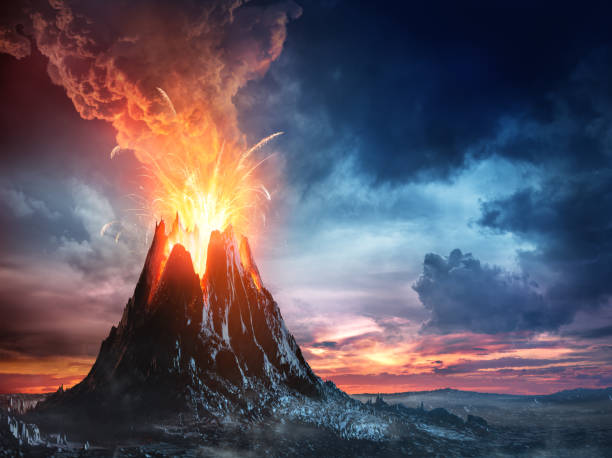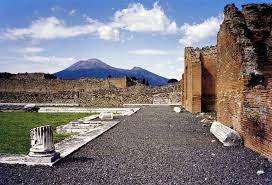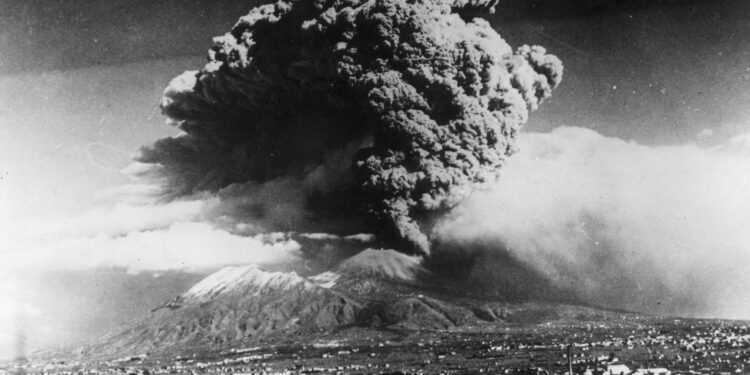Super Volcanoes

The term “super-volcano” implies a volcanic center that has had an eruption of magnitude 8 on the Volcano Explosivity Index (VEI), meaning that at one point in time it erupted more than 1,000 cubic kilometers (240 cubic miles) of material. In the early 2000s, the term “super-eruption” began being used as a catchy way to describe VEI 8 eruptions. Explosive events of this size erupt so much magma that a circular-shaped collapse feature, called a caldera, forms above the evacuated magma storage region.
Volcanoes that have produced exceedingly voluminous pyroclastic eruptions and formed large calderas in the past 2 million years include Yellowstone in northwest Wyoming, Long Valley in eastern California, Toba in Indonesia, and Taupo in New Zealand. Other ‘super volcanoes’ would likely include the large caldera volcanoes of Japan, Indonesia, Alaska (e.g. Aniakchak, Emmons, Fisher), and other areas.
volcano eruption
The world’s largest eruption of the 20th century occurred in 1912 at Novarupta on the Alaska Peninsula in what is now Katmai National Park and Preserve. An estimated 15 cubic kilometers of magma was explosively erupted during 60 hours beginning on June 6th. This volume is equivalent to 230 years of eruption at Kilauea (Hawaii) or about 30 times the volume erupted by Mount St. Helens (Washington).
The May 18, 1980 eruption of Mount St. Helens (Washington) was the most destructive in the history of the United States. Novarupta (Katmai) Volcano in Alaska erupted considerably more material in 1912, but owing to the isolation and sparse population of the region, there were no human deaths and little property damage. In contrast, the eruption of Mount St. Helens caused loss of lives.
Phlegraean Fields
Phlegraean fields is a large region of super volcanic calderas situated to the west of Naples, Italy. In 2003, it was designated as a regional park. There are 24 craters and volcanic structures in the caldera area, the most of which are submerged. Lucrino, Agnano, and the town of Pozzuoli all have hydrothermal activity. The mythical birthplace of the Roman god of fire, Vulcan, the Solfatara crater also experiences effusive gaseous manifestations. The Vesuvius Observatory keeps a close eye on this region. It’s classified as a super volcano.
Phlegraean Fields eruption
- The initial Phlegraean era. The Campanian Ignimbrite eruption is believed to have been caused by the Archiflegreo volcano’s eruption that erupted approximately 39,280 110 years ago (an earlier estimate put the date at around 37,000 years) and released roughly 200 km3 (48 cu mi) of magma (a bulk volume of 500 km3 (120 cu mi)). It had a VEI (Volcanic Explosively Index) of 7.
- Between 35,000 and 10,500 years ago was the Second Phlegraean Period. The Neapolitan yellow tuff, the remains of a massive underwater volcano with a circumference of roughly 15 kilometers (9.3 miles), which has Pozzuoli at its centre, is what distinguishes this region. The last significant eruption took place about 12,000 years ago, creating a smaller caldera inside the larger one, with Pozzuoli, today’s town, as its hub.
- The Third Phlegraean Period, between 8,000 – 500 years ago. This is characterized by white pozzolana, the material that forms the majority of volcanoes in the Fields. Broadly speaking, it can be said there was initial activity to the southwest in the zone of Bacoli and Baiae (10,000–8,000 years ago); intermediate activity in an area centered between Pozzuoli, Spaccata Mountain and Agnano (8,000–3,900 years ago); and more recent activity towards the west, which formed Lake Avernus and Monte Nuovo (New Mountain) (3,800–500 years ago).
Mount Vesuvius

Mount Vesuvius is a somma-stratovolcano located on the Gulf of Naples in Campania, Italy, about 9 km (5.6 mi) east of Naples and a short distance from the shore. It is one of several volcanoes forming the Campanian volcanic arc. Vesuvius consists of a large cone partially encircled by the steep rim of a summit caldera, resulting from the collapse of an earlier, much higher structure.
The eruption of Mount Vesuvius in AD 79 destroyed the Roman cities of Pompeii, Herculaneum, Oplontis, Stabiae, and several other settlements. The eruption ejected a cloud of stones, ashes and volcanic gases to a height of 33 km (21 mi), erupting molten rock and pulverized pumice at the rate of 6×105 cubic meters (7.8×105 cu yd) per second. More than 1,000 people are thought to have died in the eruption, though the exact toll is unknown. The only surviving eyewitness account of the event consists of two letters by Pliny the Younger to the historian Tacitus.
Volcano-logy
Volcano-logy is a young and exciting career that deals with the study of one of the earth’s most dynamic processes – volcanoes. Scientists of many disciplines study volcanoes. Physical volcanologists study the processes and deposits of volcanic eruptions.
Basically, the goals of volcano-logy are to understand how and why volcanoes erupt, how to predict eruptions, their impacts on the history of the Earth and how they may affect humans and their environment.
https://timesofindia.indiatimes.com/topic/indian-active-volcano/news?from=mdr



